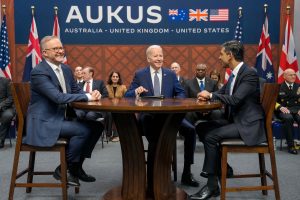In September 2021, Australia, the United Kingdom, and the United States announced AUKUS, a new security partnership to counter China’s aggressive moves in the Indo-Pacific region. The fulcrum of the partnership is an ambitious plan to provide Australia with nuclear-powered submarines, based on British and American technology and know-how.
Australia’s participation in AUKUS demonstrates a strategic divergence from Southeast Asian states in managing the rise of China. For the former, there is a growing perception that China is a significant military threat. More than 75 percent of Australians surveyed in a Lowy Institute Poll in 2022 held such perceptions, a sharp increase from 41 percent in 2009.
On the contrary, Southeast Asians generally believe that China’s rise should not be perceived only in a negative light, as the region has benefited from Beijing’s economic growth. For instance, ASEAN’s trade in goods with China grew from about $142 billion in 2012 to more than $280 billion in 2021, higher than ASEAN’s trade in goods with the United States.
The divergent threat perception vis-a-vis China between Australia and Southeast Asian states is demonstrated through Australia’s decision to turn to the United States and United Kingdom through AUKUS to acquire nuclear submarines. Australia will also allow the U.S. to operate their own submarines from a naval base near Perth as early as 2027.
Australia’s closing of ranks with the Americans and British on military cooperation initially drew sharp responses from several Southeast Asian states. Malaysia and Indonesia were the most vocal critics, expressing fears that AUKUS could lead to a regional arms race and further instability.
The most recent AUKUS announcement in March this year drew a more muted response from Southeast Asian states, suggesting a more nuanced acceptance of AUKUS and their hope to benefit from it. Several regional defense officials I engaged recently acknowledged that AUKUS is here to stay. They also pointed out that despite the initial reservations on AUKUS, they generally understand it is Australia’s sovereign right to determine its defense strategy.
However, there is a general perception that there is room for improvement in Australia’s management of AUKUS. For one, the AUKUS narrative has been primarily focused on nuclear submarines. To be clear, AUKUS is about more than just acquiring nuclear submarines for Australia, covered under AUKUS Pillar 1. Under Pillar 2, there are other areas of mutual interest for the three AUKUS partners, including capabilities in cyberspace, undersea surveillance, electronic warfare, and artificial intelligence.
Yet, as one ASEAN defense official put it to me, the extensive focus on Pillar 1 is a glaring strategic communication blunder for the Australians. In his view, Australia should emphasize AUKUS Pillar 2, which could provide an opportunity for closer defense relations with Southeast Asian states through assistance in improving their defense capabilities.
To be sure, some of the Southeast Asian defense officials I engaged with are under no illusion that Australia will be open to sharing the most advanced military technology acquired through AUKUS. However, the military condition of several Southeast Asian states, especially those having territorial disputes with China in the South China Sea, leaves much to be desired. This situation leads some ASEAN defense officials to perceive that AUKUS could benefit regional states through the programs covered under Pillar 2.
One area where Australia could assist Southeast Asian states is cybersecurity. According to a study by Recorded Future, numerous servers in Southeast Asia were targeted by suspected Chinese state-sponsored actors in a nine-month period in 2021. At the top of the target list was Malaysia, followed by Indonesia and Vietnam. Some targeted organizations include the Malaysian Defense and Foreign Affairs Ministries and the Central Office of Vietnam’s Communist Party.
Another potential area of cooperation is undersea capability. Southeast Asia’s seabed contains numerous submarine cables, with some linking Australia to other parts of the world. A substantial number traverse through the Indonesian archipelagic waters. Yet Indonesian naval officials shared that they lack the means to monitor undersea activities conducted by external powers.
Any Australian efforts to share military technology acquired through AUKUS with Southeast Asian states, however, may face one critical hurdle. The United States, a key partner in AUKUS, must reform its export control laws (i.e. International Traffic in Arms Regulations) to enable technology cooperation or assistance to external partners. Thus, Australia will have to work hard to convince the United States that some capabilities acquired through AUKUS could be used to assist critical Southeast Asian states in improving their defense capabilities.
Southeast Asian states were caught by surprise when Australia launched AUKUS in 2021. However, Australia-Southeast Asian defense relations could be deepened if the former leverages AUKUS Pillar 2 to contribute to Southeast Asia’s security. This strategy may shape the perceptions of Southeast Asian states that Australia, through AUKUS Pillar 2, serves to protect instead of undermine their security interests. This positive perception is critical, given that Australia has to live with Southeast Asian states.
































